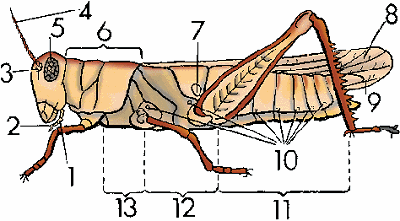Illustration of insect

- 1 labial palpus
- 2 maxillary palpus
- 3 simple eye
- 4 antenna
- 5 compound eye
- 6 prothorax
- 7 tympanum
- 8 wing
- 9 ovipositor
- 10 spiracles
- 11 abdomen
- 12 metathorax
- 13 mesothorax









The bodies of insects have segments, or divisions, so they appear to have a series of notches cut into them. This led the Greek philosopher Aristotle to give insects the name entomon “a thing cut into.” Entomon comes from the prefix en- “in,” combined with the verb temnein “to cut.” Later, when the Romans wanted a word for this kind of creature, they did not simply borrow the Greek word. Instead they translated it with the Latin word insectum, from the verb insecare “to cut into.” Insectum was borrowed into English as insect.
 Alissa Simon, Variety, 16 Feb. 2025
In addition to butterflies, the mountain supports 195 species of birds, 13 reptile species, six amphibian species, small mammals, and rare insects such as the San Francisco Forktail Damselfly, according to San Bruno Mountain Watch.
—
Alissa Simon, Variety, 16 Feb. 2025
In addition to butterflies, the mountain supports 195 species of birds, 13 reptile species, six amphibian species, small mammals, and rare insects such as the San Francisco Forktail Damselfly, according to San Bruno Mountain Watch.
— Ryan MacAsero, The Mercury News, 13 Feb. 2025
Bumblebees and other insects were there too and had editors snapping away to capture the true-to-nature iridescence of their wings.
—
Ryan MacAsero, The Mercury News, 13 Feb. 2025
Bumblebees and other insects were there too and had editors snapping away to capture the true-to-nature iridescence of their wings.
— Lily Templeton, WWD, 10 Feb. 2025
Sought after by collectors and enthusiasts, exotic insects are highly popular and often sold online and underground, authorities said.
—
Lily Templeton, WWD, 10 Feb. 2025
Sought after by collectors and enthusiasts, exotic insects are highly popular and often sold online and underground, authorities said.
— Jon Haworth, ABC News, 5 Feb. 2025
See all Example Sentences for insect
Jon Haworth, ABC News, 5 Feb. 2025
See all Example Sentences for insect 

“Insect.” Merriam-Webster.com Dictionary, Merriam-Webster, https://www.merriam-webster.com/dictionary/insect. Accessed 19 Feb. 2025.
insect
noun
from Latin insectum "insect," derived from insecare "to cut into," from in- "in" and secare "to cut" — related to dissect, section
Nglish: Translation of insect for Spanish Speakers
Britannica.com: Encyclopedia article about insect



Share